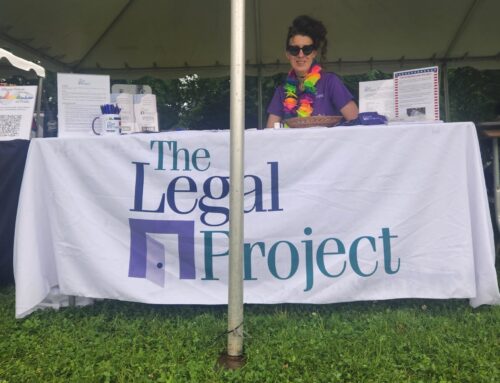By Carla Brogoch, Legal Director of The Legal Project
October is Domestic Violence Awareness month. While domestic violence is an issue that affects people every day of the year, the purpose of an awareness month is to capture the attention of general society on the issue so that it can be discussed, understood, and addressed. This is especially important for an issue like domestic violence, which thrives on secrecy and being hidden in private.
The term “domestic violence” is somewhat misleading, as it implies a focus on physical violence. In reality, domestic violence encompasses a much wider array of harmful behaviors within a relationship. The goal of the abuser is to control someone they are in an intimate relationship with. Abusers will use any tool at their disposal to establish and maintain control over the life or lives of their victim(s). The widely accepted definition of domestic violence is that it is a pattern of behaviors used by one partner to maintain power and control over the other within an intimate relationship. These tools of control include isolation, stalking, financial abuse, emotional abuse, intimidation, psychological abuse, threats, sexual abuse, and physical violence. This type of control is also referred to as “coercive control.”
Coercive control involves a strategy of psychological abuse that is often comprised of behaviors that are legal. This does not mean they are not abusive. It only means that it is very difficult within our current legal frameworks to address these behaviors for what they are. Even if a person is being abused by their partner in a way that is recognized by domestic violence experts as abuse, they might not be able to access criminal court intervention in their relationship because what their partner is doing is not actually against the law. Abusers become very good at “toeing the line” and presenting themselves to the world as upstanding citizens, caring partners, and loving parents.
We are taught by movies and television that domestic violence means explosive anger, thrown objects, and black eyes. So, when these things are not present in our friends’ relationships, or in our own, even if we feel something is “off,” we might not recognize what is going on. We might not see the coercive control for what it is — domestic violence.
With coercive control, behaviors that are normal within relationships are twisted into tools to instill fear and compliance in an intimate partner. Often the behaviors are slowly escalated by the abuser, allowing the coercive control to creep into your life by degrees. For example, it is normal to have “check-ins” in a healthy relationship. You might text your partner to let them know you got to work okay or that you are on your way home. So, when they request that you text them every day to tell them you are at work, it seems normal. When they then want to know who was at work with you that day or who you spoke with, it seems like they are just interested in your day. When they begin stopping by your work to check that you are there or calling your supervisor to check in on you, you tell yourself they are just worried about you or that it is normal to check on a partner’s faithfulness when they are out of the house. When they demand that you text them on your way home every day now, it might be a minor inconvenience, but you do it because they say they care about you. When they start timing your trip home each night and interrogating you about why you were a few minutes late, it seems to be part of the established “normal” within your relationship. They can now start forbidding you from stopping to see a friend after work, from leaving the house without them or your children in tow, or from working outside the home at all.
These expectations placed on you may be backed up with physical violence towards you, your children, your family, your pets. Or by threats of violence, or yelling and explosive behavior. But they don’t have to be. You might just never leave your home or your partner’s side without them because you don’t want to deal with them getting angry about where you went and who you talked to.
Coercive control within an intimate relationship is like a slow-acting poison. Many times it can start out in a seemingly innocent way because abusers use society’s concepts of love and jealousy to their advantage. The lines between what is acceptable within a relationship and what is abuse start to blur. Meanwhile, you are being isolated from friends and family, making it harder for you to analyze a partner’s behavior for red flags. You spend a lot of your time and mental energy appeasing your partner’s frustration and anger with you and trying to figure out ways to change your own behavior to make things at home more peaceful for everyone. You are slowly lulled into believing that your partner’s behavior is normal, or that they are acting this way because they love you, or maybe that they are acting this way because you have issues and you need their help, or maybe they are the only person in your life who actually cares about you, or maybe everything they say about you is true, and you are never going to find anyone else who will put up with having to be with you.
In the fifteen years that I have provided direct legal services to victims of domestic violence many clients have discussed with me their process of realizing that what they were experiencing in their relationship was abuse. They often didn’t realize they were being abused until they were confronted with a list of “red flags.” Many of them said things along the lines of “I wish my partner would have just hit me” or “It was easier when they were hitting me because I knew what that was.” Over and over people express that the coercive control element of domestic violence is the most difficult to deal with because it makes you doubt yourself and your ability to realize what is going on.
Isolation also plays a big role in coercive control. This isolation can be both personal — keeping someone from having friends or seeing their family, and community-based — aimed at keeping the victim from accessing any type of services that may help them escape. Again, the abuser starts with somewhat accepted behavior that escalates. You may experience a friend’s domestic violence situation as their new partner constantly texting, calling, and interrupting when your friend hangs out with you. You may be annoyed with your friend for not putting their foot down with this behavior, for not focusing their time with you on you. You may eventually stop seeing that friend as much because their partner is too annoying for you to deal with. This is all part of the abuser’s strategy to keep your friend away from any outside help. Your friend accepts your annoyance at them as being their fault and their issue to deal with because that is how they have been trained in their relationship — that other people’s annoyance, frustration, and anger with them is their problem to fix.
If the victim of abuse is part of a marginalized community, more avenues of coercive control open up to their abuser. An immigrant or undocumented victim might fear that calling the police or accessing the intervention of the court system will result in immigration consequences for them. A person who identifies as LGBTQIA+ may fear outing to their family, workplace, or the court system. Likewise, people of color may have genuine concerns with racism within the legal and policing communities. Abusers are very good at harnessing these societal issues to enable them to further isolate and control their victims.
A list of behaviors that are identified as being abusive within an intimate relationship is available here: https://www.thehotline.org/is-this-abuse/abuse-defined/
If you or someone you know is being abused, you can call the National Domestic Violence Hotline for resources in your community for help at 1−800−799−7233 or TTY 1−800−787−3224.



